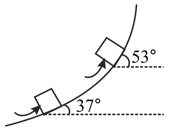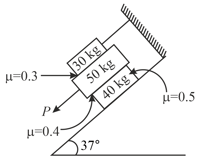A man can just push a box on slope. When he keeps it at the point where the angle increases to he can just hold it from sliding back. If the coefficient of function between the box and the slope is find Assume that the man is applying same magnitude of force along the tangent to the curve only.



Important Questions on Newton's Laws of Motion (With Friction)
A man of mass is pushing a heavy box on a flat floor. The coefficient of kinetic and static friction between the floor and the box is and the coefficient of static friction between the man's shoes and the floor is If the man pushes horizontally (see figure), what is the maximum mass (in ) of the box he can move?

In the following figure shows an accelerating conveyor belt inclined at an angle above horizontal. The coefficient of friction between the belt and block is Find the least time (in sec) in which block can reach the top, starting from rest at the bottom.

In the figure shown, find the minimum force (in ) to be applied perpendicular to the incline so that the block does not slide.

A block of is placed on a rough horizontal surface and is pulled through a variable force (in ) where is time in second, at an angle of with the horizontal as shown in figure. The coefficient of static friction of the block with the surface is one. If the force starts acting at if the time (in ) at which the block starts to slide is found to be Find.
A block of mass is placed on a wedge of an angle , as shown. The block is moving over the inclined surface of the wedge of mass . The friction coefficient between the block and the wedge is , whereas it is between the wedge and the horizontal surface. If the minimum value of , so that the wedge remains stationary on the surface is found to be . Find the value of . Take, .

Two wedges, each of mass , are placed next to each other on a flat horizontal floor. A cube of mass is balanced on the wedges as shown in the figure. Assume no friction between the cube and the wedges, but a coefficient of static friction between the wedges and the floor. What is the largest ratio of , so that the system can be balanced without the motion of the wedges?

The three flat blocks in the figure are positioned on the incline and a force parallel to the inclined plane is applied to the middle block. The upper block is prevented from moving by a wire which attaches it to the fixed support. The masses of three blocks in and coefficient of static friction for each of the three pairs of contact surfaces are shown in the figure. If the maximum value which force may have before slipping takes place anywhere is found to be . Find the value of .

A block of mass is placed over a rough inclined plane as shown in the figure. The coefficient of friction between the block and the plane is A force is applied on the block at an angle of Find the contact force (in ) between the block and the plane.


